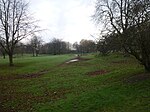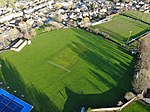Bourne railway station
Bourne, LincolnshireDisused railway stations in LincolnshireFormer Great Northern Railway stationsPages with no open date in Infobox stationRailway stations in Great Britain closed in 1959 ... and 2 more
Railway stations in Great Britain opened in 1860Use British English from August 2015

Bourne was a railway station serving the town of Bourne in Lincolnshire, which opened in 1860 and closed to passengers in 1959.
Excerpt from the Wikipedia article Bourne railway station (License: CC BY-SA 3.0, Authors, Images).Bourne railway station
Great Northern Gardens, South Kesteven Elsea Park
Geographical coordinates (GPS) Address Nearby Places Show on map
Geographical coordinates (GPS)
| Latitude | Longitude |
|---|---|
| N 52.76398 ° | E -0.37774 ° |
Address
Great Northern Gardens 65
PE10 9EH South Kesteven, Elsea Park
England, United Kingdom
Open on Google Maps









